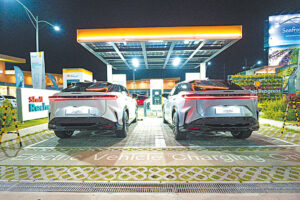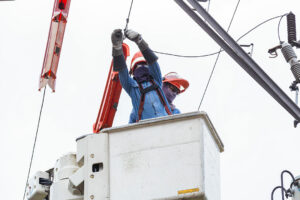Batt wait, there’s more

THERE WAS a time when the question, “What mileage do you get on your car?” would get you a reply of “xx kilometers per liter” or “xx miles per gallon.” These days, the answer could very well be 400 or even a thousand kilometers. That is because the growing interest in electrified vehicles (xEVs) is shifting the conversation from efficiency to range.
In the glory days of the internal combustion engine (ICE), terms such as “gas guzzler” or “gas miser” were common labels attached to vehicles. High-performance cars would normally be categorized in the former and smaller cars in the latter. Big-sized engines with more than the usual four cylinders were known to guzzle fuel and, conversely, small-displacement motors were miserly in their consumption of gasoline.
Driving habits were also associated with how much or how little your fuel consumption would be. The lead-footed drivers — those who often stepped on the gas pedal with much gusto — would empty their fuel tanks much faster than their feather-footed brethren. Drivers would learn to “free-wheel” (the act of shifting to neutral and letting the car’s inertia propel itself) even for a few meters to save a little on gasoline. Some drivers would even turn the engine off to avoid idling — and the consumption of gas — while waiting for the light to turn green.
Yes, those were my days. They were about consuming less gas — or diesel — in order to save money at the pump and, for the early generation of green warriors, reduce the environmental impact of vehicles. The opposite, of course, was that you stepped on the throttle more vigorously to get more driving thrills and feels. I recall that getting 10kpl or better was already some kind of badge of honor, with most cars averaging in the mid-to-high single digits.
Fast-forward to today where electrified vehicles are upending conventional wisdom about what matters in a car. These days, it’s not how much gasoline you consume but what powers your vehicle that counts more. Are you running on fossil fuel, battery, or a combination thereof? Petrol is increasingly being taken out of the equation — and the conversation. It’s getting less about what fuels your car and more about what powers it. Nickel-hydride batteries? Lithium batteries? Solid-state batteries? Fuel cells? Hydrogen? Batteries are the new propellants.
And, by the way, battery electric vehicles (BEVs) no longer have fuel tanks and engines; they have motors, inverters and, of course, batteries — the three essential components of a BEV. Has the car now truly transformed into an appliance? It used to be that ICE cars were issued fuel efficiency ratings that were displayed on vehicles to inform buyers. Perhaps, these will be replaced soon by energy-efficiency ratings like those found on air-conditioners or refrigerators.
Conversations involving EVs inevitably revolve around range. How far can one go on a fully charged battery? What’s the fuel consumption of a particular ICE car? Occasionally, you might get asked, “How big is your fuel tank?” The answer, multiplied by efficiency, will give you range. In BEVs, I guess, the equivalent question would be, “How big is your battery capacity?” The bigger your battery and the fuller it is charged means you can cover more miles. This is the crux of ambivalence among car buyers, when mulling over remaining with an ICE vehicle or making the switch to a BEV.
For one, BEVs still give potential buyers range anxiety. They worry over running out of power while on the road. I would liken this to the “low batt” syndrome that mobile phone users dread. That’s why many carry their phone charger, a power bank, or a spare battery with them. I suppose this could be done for BEVs as well, but it would bring many times more the inconvenience that mobile phone users have to deal with. In fact, I would be so bold to say that most of the range apprehensions for BEVs stem from people’s personal mobile phone experience.
Range is such a critical consideration because the recharging infrastructure for EVs is still in its infancy. Thanks to private-sector proponents like the Ayala Group, the number of charging stations is growing at a rapid clip — albeit mostly in the metro area as yet. If the charging network becomes as vast as that of petrol stations, concerns about range anxiety would be rendered moot, as in the case of ICE cars. In fact, I remember a time when some off-roaders would carry a spare container of fuel in case they run out of gas before they could get a refill. That is why it is just as important for BEV users to map out through mobile apps where the closest or next charging station is located.
In order to go farther on a tank of gas, you have to drive efficiently — shifting gears properly, accelerating smoothly, braking gently, and attacking curves efficiently. In BEVs, going farther on a fully charged battery depends on, quite literally, the amount of electric power you consume as you drive. Braking a lot, would you believe, is a good thing because it creates regenerative power that helps charge batteries as you drive. And, by the way, no power is consumed while idling. On the other hand, how hard you accelerate still increases consumption. So do topography and ambient conditions. However, BEVs are particularly sensitive to inclines and extreme temperatures.
Other growing pains for xEVs — particularly BEVs — are getting car financing, as well as insurance, for these vehicles. At the heart of the matter is that there is not enough experience or data yet in the Philippines to determine the residual value (in the case of financing) and the claims cost (in the case of insurance) for them. Surely, this is an evolving situation that will solve itself over time.
Whatever you decide, the important thing is that your car delivers on your needs. In terms of your use, it should get you to places reliably, and it should allow you to have fun getting there. Of course, it should also make your ownership experience seamless and painless. It used to be that the onomatopoeic “vroom-vroom” would immediately evoke a thrilling drive. With BEVs being as quiet as they are, what could possibly characterize their appeal?




